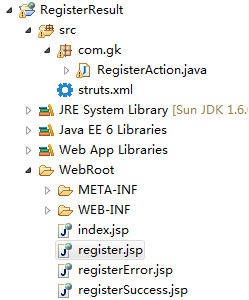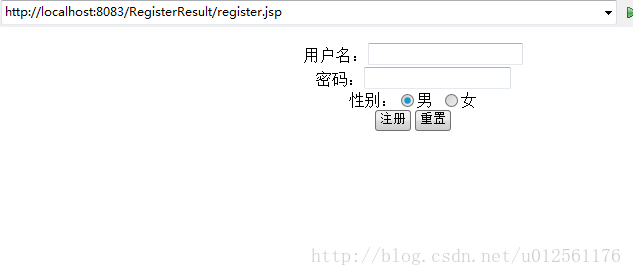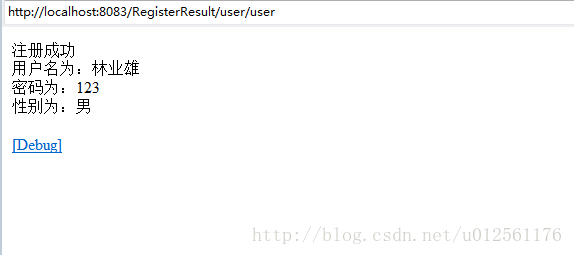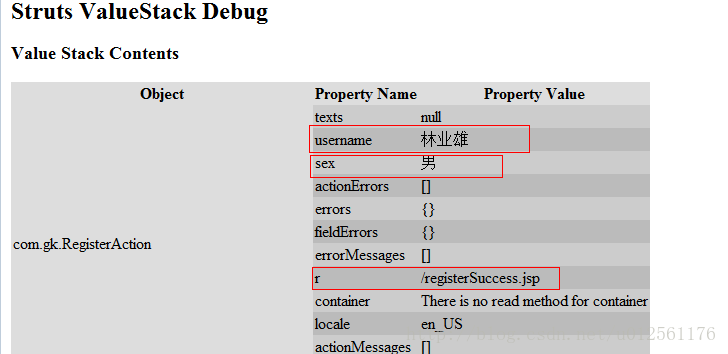Struts2中动态的指定返回的结果集
1.在Struts2中,可以在struts.xml配置文件中动态的指定返回的结果集。用${属性名}的方式取得Action类中的属性,在服务端判断好相应的跳转路径,然后存到变量里,然后再在struts.xml配置文件中用ognl表达式 ${属性名} 这种方式取出来,可以极大的增加配置文件的灵活性。接下来用一个例子来介绍如何动态的指定返回的结果集。
注:其中一定要为动态结果的保存值设置set和get方法。
2.首先,新建一个Struts2项目,项目名为RegisterResult,项目结构如下图所示:
(1).新建一个register.jsp页面,要求我们输入用户名,密码,性别,点击注册按钮后提交表单信息到Action,具体代码如下:
<%@ page language="java" import="java.util.*" pageEncoding="utf-8"%>
<%
String path = request.getContextPath();
String basePath = request.getScheme()+"://"+request.getServerName()+":"+request.getServerPort()+path+"/";
%>
<!DOCTYPE HTML PUBLIC "-//W3C//DTD HTML 4.01 Transitional//EN">
<html>
<head>
<base href="<%=basePath%>">
<title>My JSP 'register.jsp' starting page</title>
<meta http-equiv="pragma" content="no-cache">
<meta http-equiv="cache-control" content="no-cache">
<meta http-equiv="expires" content="0">
<meta http-equiv="keywords" content="keyword1,keyword2,keyword3">
<meta http-equiv="description" content="This is my page">
<!--
<link rel="stylesheet" type="text/css" href="styles.css">
-->
</head>
<body>
<center>
<form action="user/user" method="post">
用户名:<input type="text" name="username"/><br/>
密码:<input type="password" name="password"/><br/>
性别:<input type="radio" value="男" name="sex" checked="checked">男
<input type="radio" value="女" name="sex">女<br/>
<input type="submit" value="注册"/>
<input type="reset" value="重置"/>
</form>
</center>
</body>
</html>
新建一个registerSuccess.jsp页面,返回注册成功后的信息,利用struts2自带的标签来获取注册信息,代码如下:
<%@ page language="java" import="java.util.*" pageEncoding="utf-8"%>
<%@ taglib uri="/struts-tags" prefix="s" %>
<%
String path = request.getContextPath();
String basePath = request.getScheme()+"://"+request.getServerName()+":"+request.getServerPort()+path+"/";
%>
<!DOCTYPE HTML PUBLIC "-//W3C//DTD HTML 4.01 Transitional//EN">
<html>
<head>
<base href="<%=basePath%>">
<title>My JSP 'user_success.jsp' starting page</title>
<meta http-equiv="pragma" content="no-cache">
<meta http-equiv="cache-control" content="no-cache">
<meta http-equiv="expires" content="0">
<meta http-equiv="keywords" content="keyword1,keyword2,keyword3">
<meta http-equiv="description" content="This is my page">
<!--
<link rel="stylesheet" type="text/css" href="styles.css">
-->
</head>
<body>
注册成功<br/>
用户名为:<s:property value="username"/><br/>
密码为:<s:property value="password"/><br/>
性别为:<s:property value="sex"/>
<s:debug></s:debug>
</body>
</html>
新建一个registerError.jsp页面,返回注册失败,并提供一个超链接让我们重新注册,代码如下:
<%@ page language="java" import="java.util.*" pageEncoding="utf-8"%>
<%
String path = request.getContextPath();
String basePath = request.getScheme()+"://"+request.getServerName()+":"+request.getServerPort()+path+"/";
%>
<!DOCTYPE HTML PUBLIC "-//W3C//DTD HTML 4.01 Transitional//EN">
<html>
<head>
<base href="<%=basePath%>">
<title>My JSP 'user_error.jsp' starting page</title>
<meta http-equiv="pragma" content="no-cache">
<meta http-equiv="cache-control" content="no-cache">
<meta http-equiv="expires" content="0">
<meta http-equiv="keywords" content="keyword1,keyword2,keyword3">
<meta http-equiv="description" content="This is my page">
<!--
<link rel="stylesheet" type="text/css" href="styles.css">
-->
</head>
<body>
注册失败!<a href="register.jsp">请重新注册</a>
</body>
</html>
(2).接着新建一个Action类,类名为RegisterAction,放在com.gk包下,其中一定不能忘了为动态结果的保存值设置set和get方法,这里就要为动态结果的保存值,即r属性设置set和get方法,代码如下:
package com.gk;
import com.opensymphony.xwork2.ActionSupport;
public class RegisterAction extends ActionSupport {
private String username;
private String password;
private String sex;
private String r;
public String getUsername() {
return username;
}
public void setUsername(String username) {
this.username = username;
}
public String getPassword() {
return password;
}
public void setPassword(String password) {
this.password = password;
}
public String getSex() {
return sex;
}
public void setSex(String sex) {
this.sex = sex;
}
public String getR() {
return r;
}
public void setR(String r) {
this.r = r;
}
public String execute(){
if(!username.equals("") && !password.equals("")){
r="/registerSuccess.jsp";
}else{
r="/registerError.jsp";
}
return "success";
}
}
(3).struts.xml配置文件的配置如下:
<?xml version="1.0" encoding="UTF-8" ?>
<!DOCTYPE struts PUBLIC
"-//Apache Software Foundation//DTD Struts Configuration 2.0//EN"
"http://struts.apache.org/dtds/struts-2.0.dtd">
<struts>
<constant name="struts.enable.DynamicMethodInvocation" value="true"></constant>
<constant name="struts.devMode" value="true"></constant>
<package name="user" namespace="/user" extends="struts-default">
<action name="user" class="com.gk.RegisterAction">
<result>${r}</result>
</action>
</package>
</struts>
注:${}的作用是用于在配置文件中从Value stack(值栈)中取值。
其中上面的配置中用${r},就表示从Value stack(值栈)中取RegisterAction类中的r这个成员属性的值,其中必须要为这个成员属性设置set和get方法。
在RegisterAction类中指定了r的值,如果用户名和密码不为空时,r就为"/registerSuccess.jsp"。通过这样就动态的确定了result的值。
3.部署此项目到Tomcat服务器上,开启Tomcat服务器,运行后如下所示:
输入用户名和密码:
点击注册按钮后,返回注册信息:
点击上图的Debug按钮,出现下图,其中用户的信息和RegisterAction类里的r属性的值都在Value stack(值栈)里面:
如果用户名和密码为空的话,返回注册失败信息,要求我们重新注册,会出现下图的情况:
点击请重新注册按钮,又会回到注册页面去了。
4.以上内容仅供大家学习参考,写得不好,请见谅,如有错误,请指出,谢谢!





